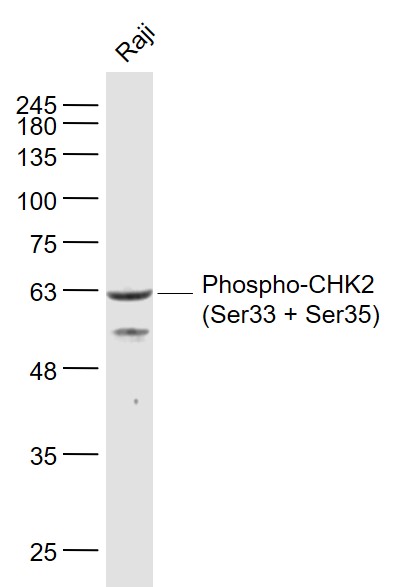
Rabbit Anti-Phospho-CHEK2 (Ser33 + Ser35)antibody
CHK2_HUMAN; Serine/threonine-protein kinase Chk2; EC:2.7.11.1; Serine/threonine-protein kinase Chk2; CDS1; CHK2; LFS2; RAD53; hCds1; HuCds1; PP1425; CHK2 checkpoint homolog; Cds1 homolog (Hucds1; hCds1); Checkpoint kinase 2;
View History [Clear]
Details
Product Name Phospho-CHEK2 (Ser33 + Ser35) Chinese Name 磷酸化细胞周期检测点激酶2抗体 Alias CHK2_HUMAN; Serine/threonine-protein kinase Chk2; EC:2.7.11.1; Serine/threonine-protein kinase Chk2; CDS1; CHK2; LFS2; RAD53; hCds1; HuCds1; PP1425; CHK2 checkpoint homolog; Cds1 homolog (Hucds1; hCds1); Checkpoint kinase 2; Research Area Tumour Cell biology Signal transduction Kinases and Phosphatases Epigenetics Immunogen Species Rabbit Clonality Polyclonal React Species Human, Applications WB=1:500-2000 IHC-F=1:100-500 ICC=1:100-500 IF=1:100-500 (Paraffin sections need antigen repair)
not yet tested in other applications.
optimal dilutions/concentrations should be determined by the end user.Theoretical molecular weight 61kDa Cellular localization The nucleus Form Liquid Concentration 1mg/ml immunogen KLH conjugated Synthesised phosphopeptide derived from human CHEK2 isoform c around the phosphorylation site of Ser33 + Ser35: SS(p-S)Q(p-S)QG Lsotype IgG Purification affinity purified by Protein A Buffer Solution 0.01M TBS(pH7.4) with 1% BSA, 0.03% Proclin300 and 50% Glycerol. Storage Shipped at 4℃. Store at -20 °C for one year. Avoid repeated freeze/thaw cycles. Attention This product as supplied is intended for research use only, not for use in human, therapeutic or diagnostic applications. PubMed PubMed Product Detail In response to DNA damage and replication blocks, cell cycle progression is halted through the control of critical cell cycle regulators. The protein encoded by this gene is a cell cycle checkpoint regulator and putative tumor suppressor. It contains a forkhead-associated protein interaction domain essential for activation in response to DNA damage and is rapidly phosphorylated in response to replication blocks and DNA damage. When activated, the encoded protein is known to inhibit CDC25C phosphatase, preventing entry into mitosis, and has been shown to stabilize the tumor suppressor protein p53, leading to cell cycle arrest in G1. In addition, this protein interacts with and phosphorylates BRCA1, allowing BRCA1 to restore survival after DNA damage. Mutations in this gene have been linked with Li-Fraumeni syndrome, a highly penetrant familial cancer phenotype usually associated with inherited mutations in TP53. Also, mutations in this gene are thought to confer a predisposition to sarcomas, breast cancer, and brain tumors. This nuclear protein is a member of the CDS1 subfamily of serine/threonine protein kinases. Several transcript variants encoding different isoforms have been found for this gene. [provided by RefSeq, Apr 2012]
Function:
Regulates cell cycle checkpoints and apoptosis in response to DNA damage, particularly to DNA double-strand breaks. Inhibits CDC25C phosphatase by phosphorylation on 'Ser-216', preventing the entry into mitosis. May also play a role in meiosis. Regulates the TP53 tumor suppressor through phosphorylation at 'Thr-18' and 'Ser-20'.
Subunit:
Homodimer. Homodimerization is part of the activation process but the dimer may dissociate following activation. Interacts with PML. Interacts with TP53. Interacts with RB1; phosphorylates RB1. Interacts with BRCA1. Interacts (phosphorylated at Thr-68) with MDC1; requires ATM-mediated phosphorylation of CHEK2. Interacts with TP53BP1; modulates CHEK2 phosphorylation at Thr-68 in response to ionizing radiation. Interacts with CDC25A; phosphorylates CDC25A and mediates its degradation in response to ionizing radiation. Interacts with CUL1; mediates CHEK2 ubiquitination and regulation.
Subcellular Location:
Nucleus; Nucleus. Isoform 10 is present throughout the cell and Nucleus > PML body. Nucleus > nucleoplasm. Recruited into PML bodies together with TP53.
Tissue Specificity:
High expression is found in testis, spleen, colon and peripheral blood leukocytes. Low expression is found in other tissues.
Post-translational modifications:
Phosphorylated by PLK4.
DISEASE:
Defects in CHEK2 are associated with Li-Fraumeni syndrome 2 (LFS2)
[MIM:609265]; a highly penetrant familial cancer phenotype usually associated with inherited mutations in p53/TP53.
Defects in CHEK2 may be a cause of susceptibility to prostate cancer (PC) [MIM:176807].
It is a malignancy originating in tissues of the prostate. Most prostate cancers are adenocarcinomas that develop in the acini of the prostatic ducts. Other rare histopathologic types of prostate cancer that occur in approximately 5% of patients include small cell carcinoma, mucinous carcinoma, prostatic ductal carcinoma, transitional cell carcinoma, squamous cell carcinoma, basal cell carcinoma, adenoid cystic carcinoma (basaloid), signet-ring cell carcinoma and neuroendocrine carcinoma. Defects in CHEK2 are found in some patients with osteogenic sarcoma (OSRC) [MIM:259500].
Similarity:
Belongs to the protein kinase superfamily. CAMK Ser/Thr protein kinase family. CHK2 subfamily.
Contains 1 FHA domain. Contains 1 protein kinase domain.
SWISS:
O96017
Gene ID:
11200
Database links:Entrez Gene: 11200 Human
Omim: 604373 Human
SwissProt: O96017 Human
Unigene: 291363 Human
Unigene: 505297 Human
Product Picture
References (0)
No References
Bought notes(bought amounts latest0)
No one bought this product
User Comment(Total0User Comment Num)
- No comment



 +86 571 56623320
+86 571 56623320
 +86 18668110335
+86 18668110335

